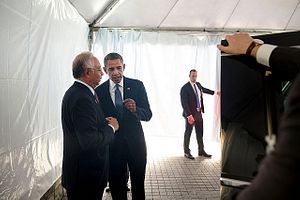Although President Barack Obama’s Asia trip earlier this month was overshadowed by the international response to the Paris attacks and debates in the United States about refugee policy, the president’s visit to Malaysia and the Philippines did offer several lessons about U.S. relations with Southeast Asia. The Obama visits to Southeast Asia, part of a longer trip that included the G-20 summit in Turkey, were intended to demonstrate the administration’s commitment to the pivot in Southeast Asia. Part of that commitment has included ensuring that high-level U.S. officials, including the president, regularly attend Association of Southeast Asian Nations (ASEAN) summits. Previous U.S. administrations had been criticized in Southeast Asia for not sending top officials to ASEAN meetings.
Although the president did make it to the ASEAN meeting in Kuala Lumpur, the fact that many of his press briefings during the trip focused, naturally, on counterterrorism policy and refugee policy, undermined some of the administration’s efforts to use the trip to highlight the importance of Southeast Asia. There was little Obama could do about this, but even administration officials admitted to Reuters that the timing of the refugee policy debates “could hardly have been worse,” and that the Asia portion of the trip did not happen as the White House had planned.
The Southeast Asia visit also confirmed that the White House has developed a strong bond with Malaysian Prime Minister Najib Razak. Despite significant evidence of a growing crackdown on dissent in Malaysia – on the eve of Obama’s trip, Human Rights Watch released an extensive report chronicling the intensifying repression of Malaysian activists, opposition politicians, journalists, and other government critics – Obama offered no public critique of Najib’s policies. (The president reportedly brought up the climate for free expression in Malaysia and the need for transparency in government in a private conversation with Najib, and Obama did meet with a group of Malaysian civil society activists.) In contrast, when Obama visited Cambodia in 2012, he spent a significant portion of a private meeting with Cambodian Prime Minister Hun Sen discussing human rights and political freedoms, and Obama’s spokespeople were not shy, after the bilateral meeting, of mentioning that rights had been a focus of the meeting.
Despite its domestic challenges, which include not only the reported crackdown on dissent but also scandals swirling around over $600 million deposited into Najib’s personal accounts, Najib’s government has proven an effective partner for the United States in counterterrorism cooperation, in building a potential deterrent to Chinese activities in the South China Sea, and on other strategic issues. (In a new piece, The Diplomat details the extent of U.S.-Malaysia counterterrorism cooperation.) It is unlikely that, were Malaysia’s opposition coalition to take over government sometime in the future, its leaders would be less interested in close strategic ties with the United States. Still, with the Malaysian opposition in turmoil, and no obvious contenders to Najib emerging within the governing coalition, it may appear to the White House that there is little alternative to the prime minister anyway.
In addition, the Obama trip revealed that, despite ASEAN’s continuing internal divisions about how to approach South China Sea disputes, the overall level of fear of China within the organization’s members is rising. At the summit in Kuala Lumpur, the United States and ASEAN signed an agreement to create a new “strategic partnership.” Although for now the U.S.-ASEAN strategic partnership is mostly a symbolic document, it sends a signal to Beijing that not only the most aggrieved Southeast Asian nations, like Vietnam and the Philippines, but all of the Southeast Asian nations, are seeking more assertive ways to hedge against China’s rising maritime power.
Joshua Kurlantzick is a fellow for Southeast Asia at the Council on Foreign Relations. This post appears courtesy of CFR.org.

































